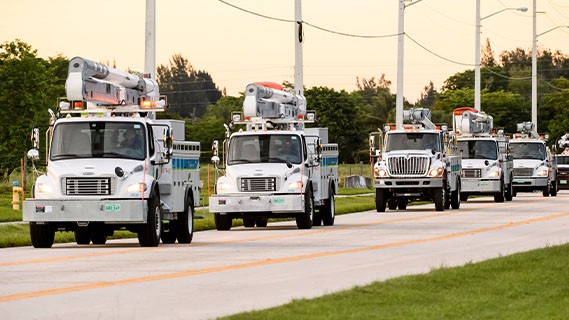/content/fplgp/us/en/storm/business/guide.html
Know Your Risk
- Determine if your business is in a flood and/or evacuation zone and review evacuation routes. If appropriate, identify a temporary emergency site. You can check FEMA’s flood maps to determine if your business location is vulnerable to storm surge or freshwater flooding.
- Have your building(s) inspected by a licensed professional to find out if your workplace is vulnerable to hurricane-force winds. Consider retrofitting your facility based on recommendations from that assessment.
Take Necessary Precautions
- Create a hurricane plan for your business. Update this plan annually and review it with your team to facilitate recovery efforts. Include action items such as reopening plans, pre-and-post storm staffing lists, storm training materials and contact lists.
- Prepare for potential power outages by updating the phone number and email address on your FPL account. Consider having a generator installed at your facility.
- If you plan to take shelter at your business, establish a safe area located away from exterior windows and doors.
- Determine what staffing and materials you need to secure your building and important equipment.
- Decide who will help secure your facility, outline specific tasks for those employees and conduct training sessions throughout the year.
- Consider providing shelter to employees and their families and helping with supplies post-storm.
Review Insurance Coverage
- Review your insurance coverage and photograph or videotape your building or office – inside and outside. Remember to document and inventory equipment and supplies as well as your building’s physical state.
- Have copies of insurance policies and the associated contact information, including phone numbers and emails.
- Make sure you have the appropriate insurance coverage. That may include, but is not limited to, Business Interruption Insurance, Accounts Receivable and Valuable Papers Coverage as well as Income Destruction Insurance and Flood Insurance.
- Have your business appraised at least every five years.
Create Communication and Recovery Plans
- Ensure your employees’ contact information is up-to-date and have a plan in place to communicate with them after a storm passes. Consider setting up a telephone number with a recorded message that will be regularly updated to inform employees of the status of company operations following a storm.
- Establish a rendezvous point and time for employees in case communications are disrupted.
- Prepare a list of vendors to provide disaster recovery services.
- Consider developing a system to authorize re-entry to company facilities after a storm, e.g. I.D. cards, vehicle permit, etc.
Gather Supplies
- Gather supplies, such as tarps, plastic bags, tape, sandbags, shutters, plywood, hand tools, generator, first aid kit, brooms, mops and towels.
- Fully charge cell phones, laptop computers and other electronics.
- Make provisions for alternate communications and power.
- Prepare to work with limited supplies of cash and be without water, sewer and/or power for at least two weeks. Store emergency supplies at the office.
Secure Your Building and Equipment
- Make multiple back-ups of necessary computer files and data. Store records off-premises.
- If dependent on data processing, consider an alternate site.
- If a storm threatens your business, secure your building and important equipment. Identify who will help, outline specific tasks for each person and conduct training sessions.
- Move items away from the windows.
- Unplug all lamps, radios, computers and equipment in case of a power surge; cover and move equipment/furniture to a secured area.
- Park vehicles in a protected area such as a covered garage.
- Lock drawers and file cabinets.
Address Special Needs
- Plan to close your offices in sufficient time to allow employees to secure their homes, obtain supplies and evacuate if necessary.
- Inform clients that you’re closing early and when you plan to reopen.
- Record a special voice message informing employees and customers of the status of company operations.
- Share your storm communications and recovery plan with your employees in advance.

Make Safety a Top Priority
- Make your safety and the safety of your employees a priority.
- Do not travel or ask employees to travel until it is safe to do so.
- Should your power go out, listen to your local news on a battery-powered radio for the latest information on power restoration. You can also visit FPL.com/storm from your computer or smartphone to report and check the status of an outage.
- Immediately call 911 to report dangerous or hazardous conditions; call FPL at 1-800-4OUTAGE to report downed power lines or damage to FPL lines, poles or transformers.
- Stay far away from fallen power lines and flooded or debris-laden areas that may be hiding downed power lines. Don’t touch anything that may be in contact with or near power lines.
- Don’t use candles; use battery-operated flashlights and lanterns instead.
- If your roof or windows leaked during the storm, water in your walls and ceiling may come into contact with electrical wiring. Immediately turn off your circuit breakers, disconnect all electrical appliances that are still plugged in and turn off all wall switches. Remember, never stand in water while operating switches or unplugging any electrical device.

- If you use a portable generator, read and follow all the manufacturer’s instructions. Be sure to set it up outside – away from open windows – and connect appliances directly to it. Do not wire your generator directly to your breaker or fuse box because the power may flow back into power lines and injure line workers. See more generator tips.
- Make emergency repairs only when it is safe to do so. Repairs that prevent looting or further damage should have top priority, but only if the repair can be done safely.